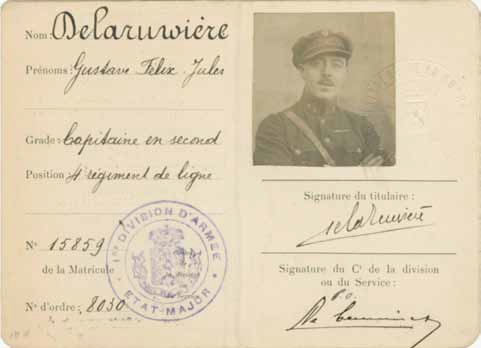| Previous page | Back to exhibition’s homepage | Next page |
|
Ondergrondse activiteiten in de jaren dertig |
Underground activities during the Thirties |
Activités souterraines pendant les années 1930 |
| BLAO – BOX | BLAO – BOX | BLAO – BOX |
| Tussen 1921 en 1939 werkt, eerst in Parijs en vervolgens in Brussel, een tripartite inlichtingendienst, samengesteld uit vertegenwoordigers van de Britse, Franse en Belgische geheime diensten. Deze inlichtingendienst heet eerst BLAO (Bureau de Liaison de l’Armée d’Occupation). Na de afschaffing van de militaire veiligheid wordt deze dienst vanaf 1930 onder de naam BOX (Bureau of Exchange) heringericht. Het BLAO-BOX kan worden beschouwd als de logische voorzetting van de samenwerking die tijdens de Eerste Wereldoorlog tussen deze drie diensten ontstond bij het intergeallieerd Bureau van Folkestone. | Between 1921 and 1939, a tripartite intelligence office composed of representatives of British, French and Belgian secret services is operationals, first from Paris, then from Brussels. This office was known as BLAO (“Bureau de Liaison de l’Armée d’Occupation”). After the suppression of the military security, it was reconstituted in 1930 as BOX (Bureau of Exchange). BLAO-BOX can be considered as the logical continuation of the collaboration that existed, during the First World War, between those three services within the intra-alliance intelligence bureau at Folkestone. | Entre 1921 et 1939 fonctionne, à Paris d’abord, à Bruxelles ensuite, un bureau tripartite de renseignements composé de représentants des services secrets britanniques, français et belges. Ce bureau est dénommé BLAO (Bureau de Liaison de l’Armée d’Occupation). Après la suppression de la Sûreté militaire, ce service est reconstitué en 1930 sous le nom de BOX (Bureau of Exchange). Le BLAO-BOX peut être considéré comme la continuation logique de la collaboration ayant existé entre ces trois services au sein du bureau interallié de Folkestone actif pendant la Première Guerre mondiale. |
| Service de contre-information | Service de contre-information | Service de contre-information |
| De Duitse herbewapening laat de Generale Staf van het Belgisch leger toe om de militaire inlichtings-en contraspionagedienst opnieuw op te richten. Het Koninklijk Besluit van 27 mei 1937 geeft de Tweede Sectie de sinds 1929 aan de Openbare Veiligheid afgestane bevoegdheden terug, samen met een korps van burgerlijke agenten. Om de nieuwe dienst geheim te houden voor het buitenland maar ook voor de Belgische pers en politici wordt het Koninklijk Besluit niet in het Staatsblad gepubliceerd. | Facing the German rearmament, the General Staff of the Belgian army tried to reinstall a military intelligence and security service. Together with a body of civil agents, the royal decree of 27 May 1937 gave this service the competence back which had been transferred to the Public Security in 1929. To keep the existence of this new service a secret for foreigners as well as for the Belgian press and politicians, the royal decree was not published in the Moniteur Belge. | Face au réarmement allemand, l’état-major de l’armée belge s’efforce de réinstaller un service de renseignement et de contre-espionnage militaires. Les compétences transférées depuis 1929 à la Sûreté publique lui sont restituées, ainsi qu’un corps d’agents civils, par un arrêté royal du 27 mai 1937. Pour maintenir secrète l’existence du nouveau service tant à l’égard de l’étranger que vis-à-vis de la presse et du monde politique belges, l’arrêté royal n’est pas publié au Moniteur belge. |
| De doelbewust vaag benoemde « Service de contre-information » (SCI) wordt toevertrouwd aan Majoor Mampuys. In zijn strijd tegen Duitse spionage, kan de SCI voor de oorlog niet minder dan 43 agenten ontmaskeren. | Deliberately endowed with a vague name, the “Service de Contre-information” (SCI) was under the command of Major Mampuys. In its struggle against the German espionage, before the Second World War, the SCI was able to arrest no less than 43 agents. | Désigné par l’intitulé délibérément vague de « Service de contre-information » (SCI), celui-ci est confié au major Mampuys. Dans sa lutte contre l’espionnage allemand, le SCI démasque avant la guerre pas moins de 43 agents. |
Onder de gearresteerde spionnen bevindt zich Belgisch Luitenant Joseph Dombret, van het Militair Cartografisch Instituut. Onder invloed van zijn vriendin Simone Pierlot verkocht hij geheime militaire documenten aan een Duitse agent.
Among the arrested spies is the Belgian Lieutenant Joseph Dombret, from the military cartographic Institute. Encouraged by his friend Simone Pierlot, he sold classified material from the army to a German intermediary.
Parmi les espions arrêtés figure le lieutenant belge Joseph Dombret de l’Institut cartographique militaire. Entrainé par son amie Simone Pierlot, il livra contre paiement à un intermédiaire allemand des documents intéressant la défense nationale.
